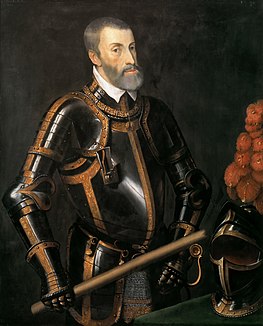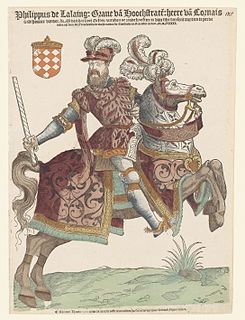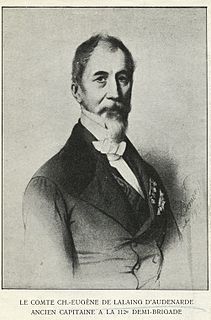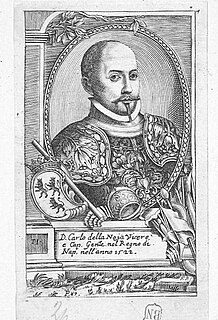Philip de Lalaing (1499–1550), also known as "the bastard of Lalaing", was an illegitimate son of Antoine I de Lalaing and Ysabeau d'Haubourdin. He was legitimised in March 1524, and served Margaret of Austria as master of the household, knight of honour, and adviser. In 1529 Margaret sent him to France as an ambassador extraordinary on behalf of Charles V, Holy Roman Emperor. [1]

Archduchess Margaret of Austria, Princess of Asturias and Duchess of Savoy by her two marriages, was Governor of the Habsburg Netherlands from 1507 to 1515 and again from 1519 to 1530.

Charles V was Holy Roman Emperor (1519–1556), King of Germany (1520-1556), King of Italy (1530-1556), King of Spain (1516-1556), King of the Indies (1521-1556), Lord of the Habsburg Netherlands (1506–1555), and head of the House of Austria (1519-1556). Charles V revitalized the medieval concept of the universal monarchy of Charlemagne and travelled from city to city, with no single fixed capital: overall he spent 28 years in the Habsburg Netherlands, 18 years in Spain, and 9 years in Germany. After four decades of incessant warfare with the Protestants, the Ottoman Empire, and the Kingdom of France, Charles V abandoned his multi-national project with a series of abdications between 1554 and 1556 in favor of his son Philip II of Spain and brother Ferdinand I of Austria. The personal union of his European and American territories, spanning over nearly 4 million square kilometres, was the first collection of realms to be defined as "the empire on which the sun never sets".
He married Florence de Rechem, Viscountess of Audenaerde. He was succeeded by their eldest son Jacques I de Lalaing, 5th Viscount of Audenaerde. Their daughter became a lady-in-waiting in the household of Philip de Lalaing, 2nd Count of Hoogstraten. One of his descendants is Charles Eugène de Lalaing d'Audenarde.
Viscount of Audenaerde was a Flemish feudal title. It was associated successively with two families.

Philip de Lalaing, 2nd count of Hoogstraten was stadtholder of Jülich (1543) and Guelders.

Charles Eugène de Lalaing d'Audenarde was an officer in the French army during the French Revolutionary Wars and the Napoleonic Wars.
He died 2 April 1550, aged fifty.








